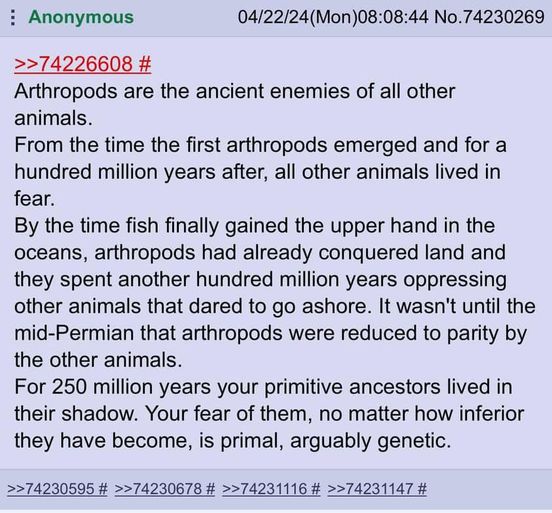this post was submitted on 29 Apr 2024
1 points (100.0% liked)
Science Memes
10271 readers
2803 users here now
Welcome to c/science_memes @ Mander.xyz!
A place for majestic STEMLORD peacocking, as well as memes about the realities of working in a lab.

Rules
- Don't throw mud. Behave like an intellectual and remember the human.
- Keep it rooted (on topic).
- No spam.
- Infographics welcome, get schooled.
Research Committee
Other Mander Communities
Science and Research
Biology and Life Sciences
- !abiogenesis@mander.xyz
- !animal-behavior@mander.xyz
- !anthropology@mander.xyz
- !arachnology@mander.xyz
- !balconygardening@slrpnk.net
- !biodiversity@mander.xyz
- !biology@mander.xyz
- !biophysics@mander.xyz
- !botany@mander.xyz
- !ecology@mander.xyz
- !entomology@mander.xyz
- !fermentation@mander.xyz
- !herpetology@mander.xyz
- !houseplants@mander.xyz
- !medicine@mander.xyz
- !microscopy@mander.xyz
- !mycology@mander.xyz
- !nudibranchs@mander.xyz
- !nutrition@mander.xyz
- !palaeoecology@mander.xyz
- !palaeontology@mander.xyz
- !photosynthesis@mander.xyz
- !plantid@mander.xyz
- !plants@mander.xyz
- !reptiles and amphibians@mander.xyz
Physical Sciences
- !astronomy@mander.xyz
- !chemistry@mander.xyz
- !earthscience@mander.xyz
- !geography@mander.xyz
- !geospatial@mander.xyz
- !nuclear@mander.xyz
- !physics@mander.xyz
- !quantum-computing@mander.xyz
- !spectroscopy@mander.xyz
Humanities and Social Sciences
Practical and Applied Sciences
- !exercise-and sports-science@mander.xyz
- !gardening@mander.xyz
- !self sufficiency@mander.xyz
- !soilscience@slrpnk.net
- !terrariums@mander.xyz
- !timelapse@mander.xyz
Memes
Miscellaneous
founded 2 years ago
MODERATORS
you are viewing a single comment's thread
view the rest of the comments
view the rest of the comments

People see insects as extremely weak but they're the ones who despite being a thousandth of your size can still consistently ruin your day. Now imagine that scaled up and given a lifespan which allows them to develop intelligence and you'll start to understand why my insectsona would absolutely fuck up your dragonsona in a fight.
The can't be bigger today however, as they are limited by the oxygen concentration in the air. In the past, there was a higher percentage of oxygen in the atmosphere, so so insects could be bigger and thus have a lower surface area to volume ratio, because the air they did intake through their exoskeleton had more oxygen, so it was possible to spread oxygen throughout their body. But when the oxygen level dropped, they had to become smaller so that their surface area to volume ratio dropped, and the oxygen they intook could go further.
More detail
During the Carboniferous period, which lasted from about 359 to 299 million years ago, giant dragonflies and huge cockroaches were common. These prehistoric insects grew to impressive sizes, and one of the leading theories behind their gigantism is the abundance of oxygen in the atmosphere at that time. Here’s how it worked:High Oxygen Levels: The rise of vast lowland swamp forests during the Carboniferous period led to atmospheric oxygen levels of around 30 percent—close to 50 percent higher than current levels. This rich oxygen environment allowed adult bugs to grow to ever larger sizes while still meeting their energy needs.
Larval Perspective: However, the new study suggests that it’s not just because oxygen affected the adults. Oxygen had a bigger effect on larvae. Insects like dragonflies and stoneflies have a larval stage where they live in water before becoming terrestrial adults. Larvae typically absorb oxygen directly through their skin, so they have little control over how much gas they take in. When oxygen levels were high, this passive absorption could lead to oxygen poisoning. To decrease this risk, growing bigger was advantageous because large larvae would absorb lower percentages of oxygen relative to their body sizes.
Regulating Oxygen Intake: Adult insects, on the other hand, can regulate their oxygen intake. They have valve-like holes called spiracles that allow them to adjust the amount of oxygen they absorb. While oxygen is crucial for life, it can be poisonous in large quantities. Humans exposed to excess oxygen can suffer cell damage, vision problems, difficulty breathing, nausea, and convulsions. Ancient insect larvae likely faced similar risks when oxygen levels were exceptionally high.
Dragonflies and Cockroaches: Not all insects responded the same way. For instance, dragonflies grew faster into bigger adults in an oxygen-rich environment (hyperoxia), while cockroaches grew slower and did not become larger adults. Overall, ten out of twelve kinds of insects studied decreased in size in lower oxygen atmospheres. The hollow tracheal tubes insects use to breathe played a crucial role in these responses.
Fossil Proxies: Understanding how modern insects respond to varying oxygen levels could help us use fossilized insects as proxies for ancient oxygen levels. By studying the plasticity of modern insects raised in different oxygen concentrations, researchers gain insights into the evolution of insects and the impact of oxygen on their size and growth.
Same for dinosaurs. They got so big because more oxygen, couldn't survive today.
There are dinosaurs right outside my window right now. I think they might be nesting, one is collecting sticks while the other is hopping across the lawn to look for worms.
And by the way, same as the extant dinosaurs, many of the extinct ones had an extremely optimized pneumatized breathing apparatus that would likely allow many to survive today. Maybe not the really big ones though.
There's five million ants for every human, should they decide to fuck us up, they will.